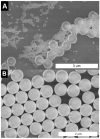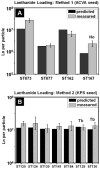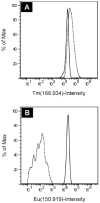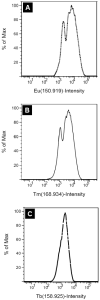Bio-Functional, Lanthanide-Labeled Polymer Particles by Seeded Emulsion Polymerization and their Characterization by Novel ICP-MS Detection
- PMID: 20396648
- PMCID: PMC2852895
- DOI: 10.1039/b916850h
Bio-Functional, Lanthanide-Labeled Polymer Particles by Seeded Emulsion Polymerization and their Characterization by Novel ICP-MS Detection
Abstract
We present the synthesis and characterization of monodisperse, sub-micron poly(styrene) (PS) particles loaded with up to and including 10(7) lanthanide (Ln) ions per particle. These particles have been synthesized by seeded emulsion polymerization with a mixture of monomer and a pre-formed Ln complex, and analyzed on a particle-by-particle basis by a unique inductively coupled plasma mass cytometer. Seed particles were prepared by surfactant-free emulsion polymerization (SFEP) to obtain large particle sizes in aqueous media. Extensive surface acid functionality was introduced using the acid-functional initiator ACVA, either during seed latex synthesis or in the second stage of polymerization. The loading of particles with three different Ln ions (Eu, Tb, and Ho) has proven to be close to 100 % efficient on an individual and combined basis. Covalent attachment of metal-tagged peptides and proteins such as Neutravidin to the particle surface was shown to be successful and the number of bound species can be readily determined. We believe these particles can serve as precursors for multiplexed, bead-based bio-assays utilizing mass cytometric detection.
Figures











Similar articles
-
Surface Functionalization Methods to Enhance Bioconjugation in Metal-Labeled Polystyrene Particles.Macromolecules. 2011 Jun 28;44(12):4801-4813. doi: 10.1021/ma200582q. Macromolecules. 2011. PMID: 21799543 Free PMC article.
-
Alkyne-rich patchy polymer colloids prepared by surfactant-free emulsion polymerization.J Colloid Interface Sci. 2025 Feb;679(Pt B):276-283. doi: 10.1016/j.jcis.2024.10.040. Epub 2024 Oct 10. J Colloid Interface Sci. 2025. PMID: 39454259
-
Platinum nanoparticles from size adjusted functional colloidal particles generated by a seeded emulsion polymerization process.Beilstein J Nanotechnol. 2011;2:459-72. doi: 10.3762/bjnano.2.50. Epub 2011 Aug 18. Beilstein J Nanotechnol. 2011. PMID: 22003452 Free PMC article.
-
Sterically and electrosterically stabilized emulsion polymerization. Kinetics and preparation.Adv Colloid Interface Sci. 2002 Oct 21;99(2):77-162. doi: 10.1016/s0001-8686(02)00005-2. Adv Colloid Interface Sci. 2002. PMID: 12405397 Review.
-
Microemulsion polymerization of styrene in the presence of a cationic emulsifier.Adv Colloid Interface Sci. 2001 Sep 3;92(1-3):195-233. doi: 10.1016/s0001-8686(00)00072-5. Adv Colloid Interface Sci. 2001. PMID: 11583298 Review.
Cited by
-
Elemental labelling combined with liquid chromatography inductively coupled plasma mass spectrometry for quantification of biomolecules: a review.Anal Chim Acta. 2012 Oct 31;750(100):98-110. doi: 10.1016/j.aca.2012.06.040. Epub 2012 Jul 8. Anal Chim Acta. 2012. PMID: 23062431 Free PMC article. Review.
-
Metal-Containing Polystyrene Beads as Standards for Mass Cytometry.J Anal At Spectrom. 2010;25(3):260-268. doi: 10.1039/b921770c. J Anal At Spectrom. 2010. PMID: 20390041 Free PMC article.
-
Signal amplification strategies for clinical biomarker quantification using elemental mass spectrometry.Anal Bioanal Chem. 2022 Jan;414(1):53-62. doi: 10.1007/s00216-021-03251-5. Epub 2021 Mar 5. Anal Bioanal Chem. 2022. PMID: 33674934
-
Surface Functionalization Methods to Enhance Bioconjugation in Metal-Labeled Polystyrene Particles.Macromolecules. 2011 Jun 28;44(12):4801-4813. doi: 10.1021/ma200582q. Macromolecules. 2011. PMID: 21799543 Free PMC article.
-
Addressing the relevance of polystyrene nano- and microplastic particles used to support exposure, toxicity and risk assessment: implications and recommendations.Part Fibre Toxicol. 2024 Sep 27;21(1):39. doi: 10.1186/s12989-024-00599-1. Part Fibre Toxicol. 2024. PMID: 39334292 Free PMC article. Review.
References
-
- Brenner S, Johnson M, Bridgham J, Golda G, Lloyd DH, Johnson D, Luo S, McCurdy S, Foy M, Ewan M, Roth R, George D, Eletr S, Albrecht G, Vermaas E, Williams SR, Moon K, Burcham T, Pallas M, DuBridge RB, Kirchner J, Fearon K, Mao Ji, Corcoran K. Nature Biotechnology. 2000;18:630–634. - PubMed
-
- Cook EB, Stahl JL, Lowe L, Chen R, Morgan E, Wilson J, Varro R, Chan A, Graziano FM, Barney NP. Journal of Immunological Methods. 2001;254:109–118. - PubMed
-
- Dunbar SA, Vander Zee CA, Oliver KG, Karem KL, Jacobson JW. Journal of Microbiological Methods. 2003;53:245–252. - PubMed
-
- Goldman ER, Clapp AR, Anderson GP, Uyeda HT, Mauro JM, Medintz IL, Mattoussi H. Analytical Chemistry. 2004;76:684–688. - PubMed
-
- Han M, Gao X, Su JZ, Nie S. Nature Biotechnology. 2001;19:631–635. - PubMed
Grants and funding
LinkOut - more resources
Full Text Sources
Other Literature Sources
